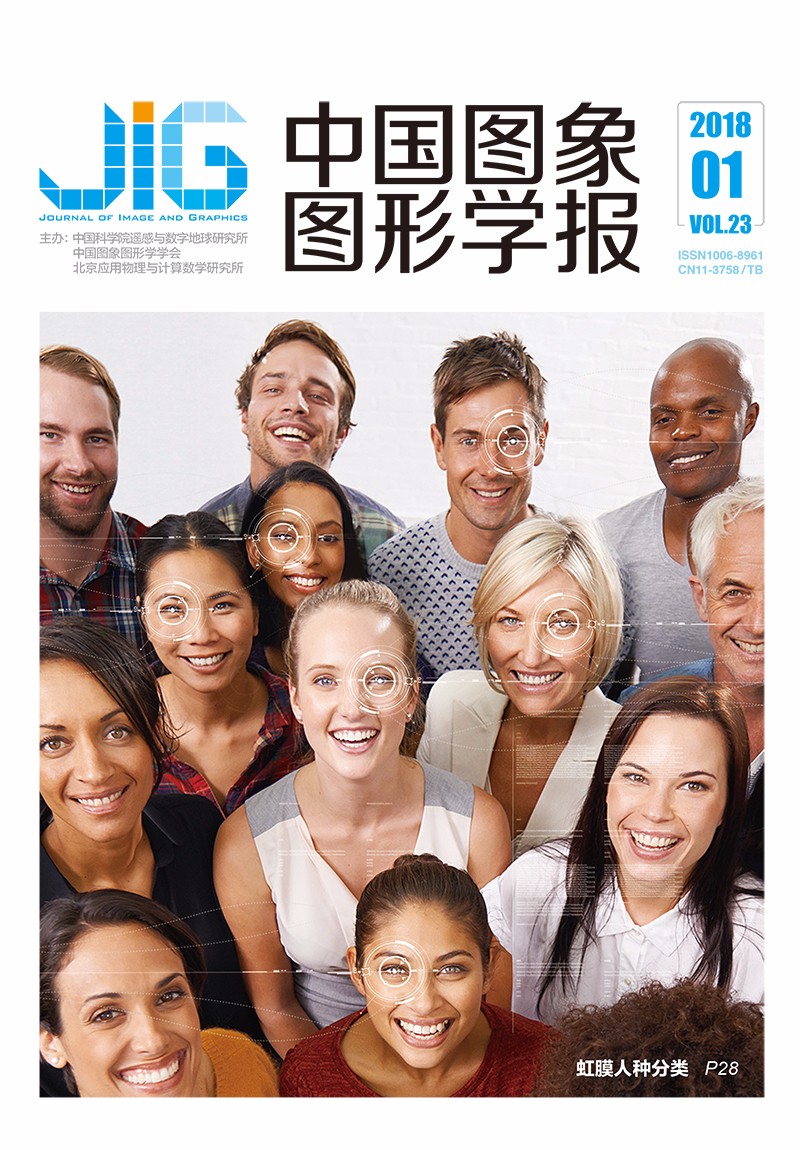
双边滤波的改进高光去除
摘 要
目的 由于非均匀光照条件下,物体表面通常出现块状的强反射区域,传统的去高光方法在还原图像时容易造成颜色失真或者边缘的丢失。针对这些缺点,提出一种改进的基于双边滤波的去高光方法。方法 首先通过双色反射模型变换得到镜面反射分量与最大漫反射色度之间的转换关系,然后利用阈值将图像的像素点分为两类,将仅含漫反射分量的像素点与含有镜面反射分量的像素点分离开来,对两类像素点的最大漫反射色度分别做估计,接着以估计的最大漫反射色度的相似度作为双边滤波器的值域,同时以图像的最大色度图作为双边滤波的引导图保边去噪,进而达到去除镜面反射分量的目的。结果 以经典的高光图像作为处理对象,对含有镜面反射和仅含漫反射的像素点分别做最大漫反射色度估计,再以该估计图作为双边滤波的引导图,不仅能去除镜面反射分量还能有效的保留图像的边缘信息,最大程度的还原图像细节颜色,并且解决了原始算法处理结果中R、G、B三通道相似的像素点所出现的颜色退化问题。用改进的双边滤波去高光算法对50幅含高光的图像做处理,并将该算法与Yang方法和Shen方法分别作对比,结果图的峰值信噪比(PSNR)也分别平均提高4.17%和8.40%,所提算法的处理效果更符合人眼视觉,图像质量更好。结论 实验结果表明针对含镜面反射的图像,本文方法能够更有效去除图像的多区域局部高光,完成对图像的复原,可为室内外光照不匀情况下所采集图像的复原提供有效理论基础。
关键词
Specular highlight removal using improved bilateral filtering
Gao Ruxin, Li Xueying(School of Electrical Engineering and Automation, Henan Polytechnic University, Jiaozuo 454000, China) Abstract
Objective Various inhomogeneous materials, including plastic, wood, ceramic, and other opaque nonconductors with uniform pigmentation, usually present some blocks of reflection areas due to nonuniform illumination conditions. However, these blocks of reflection areas often exert some negative effects on visual quality and degrade the performances of vision algorithms, such as color constancy, image segmentation, visual tracking, and object detection. For simplification, specular components are usually disregarded as outliers by methods based on diffuse component analysis. When we use traditional methods to remove the highlight of a simple image, they cannot completely separate the specular components of the image. For example, the colors and edges of images were always missed, parts of the result image exhibited color distortion, caused artifacts for noisy and highly textured surfaces, the method was inapplicable to natural images. In view of these shortcomings, an improved method of removing highlights based on bilateral filtering is proposed. Method To solve the shortcomings of the traditional methods, we raise an improved bilateral filtering method. The method comprises three stages. First, we can determine the relationship between the diffuse component and the maximum diffuse chromaticity of pixels in an image according to the dichromatic reflection model and by assuming that illumination chromaticity can be measured (with a white reference). If we want to separate the diffuse component from an image, then we must estimate the maximum diffuse chromaticity value for every pixel. An estimation of the maximum diffuse chromaticity, which is the key to separating specular and diffuse components, is thus necessary. Second, we use an appropriate threshold to divide the input image into two categories. The first class of pixels contains only a diffuse component, whereas the second class of pixels includes specular and diffuse components. We then implement our proposed method (two different algorithms) to estimate the maximum diffuse chromaticity of the two categories. We adopt a compensation function in the second class of pixels. This compensation function can exert a positive effect on pixels with similar RGB channels, as well as avoid the negative effect of the specular component of the second class of pixels. Third, we use the approximated maximum diffuse chromaticity in the second step to guide the smoothing and iteratively apply joint low-pass filter (bilateral filter) to update the maximum diffuse chromaticity estimation. This stage is based on a key observation that the maximum diffuse chromaticity in local patches in colorful images generally changes smoothly. We update the maximum diffuse chromaticity after every iteration. The maximum diffuse chromaticity values can be gradually propagated from diffuse pixels to specular pixels. Our algorithm does not stop until an insignificant difference (set at 0.02 in our experiments) exists between the updated and filtered maximum diffuse chromaticity values. In practice, our method generally converges after two to four iterations. As a result, our method can remove highlights more efficiently than previous methods. Result In this study, we use classic images with highlights as processing objects and yield a new maximum diffuse chromaticity estimation of pixels that contain specular and diffuse reflections. We also yield a new maximum diffuse chromaticity estimation of remaining pixels that contain only diffuse reflection. With the maximum diffuse chromaticity image as a bilateral filtering guide map, we can remove the specular reflection component, as well as effectively preserve the image edge information. We remove the specular component of the pictures, and the color degradation of pixels with similar values in RGB channels is reduced. In the experiment, the proposed algorithm is compared with the methods of Yang et al. and Shen et al. We compare the peak-signal-to-noise ratios of 50 pictures and determine that our result images increase by 4.17% and 8.40% in average. The processing effect of the proposed algorithm is in line with the human eye vision. The experimental results on synthetic and real images show that our method performs better than the state-of-the-art methods in separating specular reflection. Conclusion We propose a new estimation of maximum diffuse chromaticity in the highlight removal field. The use of a low-pass filter guarantees the estimated diffuse reflections. With a single color image, the highlight removal problem is formulated as an iterative bilateral filtering process that normally converges in two to four iterations. The experimental evaluation indicates that the proposed method can effectively remove the specular reflection components from images. We also provide an effective theoretical basis for indoor and outdoor images with specular reflection. Our future works involve solving the limitations of our method and practically applying it.
Keywords
dichromatic reflection model specular reflection component the maximum diffuse chromaticity estimation range bilateral filtering
|



 中国图象图形学报 │ 京ICP备05080539号-4 │ 本系统由
中国图象图形学报 │ 京ICP备05080539号-4 │ 本系统由